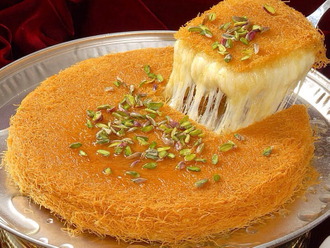|
|
Ahmad Ayoub |
Dubai has been the main entrepot in the Arabian Gulf and the busiest trading port since 1920, with commerce being the main source of revenue for the emirate. This resulted in the emergence of Dubai as the premier re-export business port, whereby goods are imported into a duty-free port and immediately exported to another market.
His Highness Shaikh Mohammad Bin Rashid Al Maktoum, Vice-President and Prime Minister of the UAE and Ruler of Dubai, has said, “This land connected ancient civilisations and will continue to be a hub that connects the world.” Expo 2020’s theme reflects Dubai’s deep roots of diversity and tolerance. The international trade which flowed from Dubai’s cosmopolitan nature in the 1920s was the basis of its prosperity. This gave the city a very early start in development before the beginning of oil production in the late 1960s.
Tolerance
Dubai was not only geographically well placed but it also provided a liberal commercial climate under Shaikh Saeed Bin Maktoum Al Maktoum who welcomed foreign merchants, craftsmen, traders and pearl divers. By the turn of the 20th century, Dubai’s facilities for trade and free enterprise were enough to make it a natural haven for merchants who came from Mumbai, Karachi, Kuwait, Manama and Lingeh.
A flourishing cosmopolitan population had also settled in Dubai and was particularly active in the shops and alleys of the souq. Dubai’s pluralism and tolerance began to attract other foreign merchants too. On International Tolerance Day, Shaikh Mohammad said that the Anti-Discrimination Law preserves our legacy of tolerance. It is indeed a legacy that the nation has inherited from previous generations.
The successful early development was due in large part to the foresight of Dubai’s rulers. During the 20th century, the city benefited from the stabilising influence of two exceptionally long rules: that of Shaikh Saeed Bin Maktoum Al Maktoum from 1912 to 1958, followed by his son, Shaikh Rashid Bin Saeed Al Maktoum.
Today’s Dubai Ports Authority was then one of the earliest government departments and known as furdhah, a classical Arabic term for ‘berth’ — the designated location in a port or harbour used for mooring ships when they are not at sea. Firmly established, the port authority was called “the Mother of Government Departments”, particularly because the Ruler’s office and most other departments were based at the Customs old building and financed through the revenue collected by customs. Under Shaikh Saeed’s rule, Dubai port grew rapidly and became a regular port of call for steamers from 1912.
The Hamal Bashi
During Shaikh Saeed’s time, the head of the port authority was Abdul Kareem Bin Mahmoud Bin Haj Qasim. The title ‘Hamal Bashi’ was given by Shaikh Saeed in the decree appointing him in 1920.
Qasim played a crucial role in the development process and in enhancing the management facilities. As a result, the port authority gained a wide regional reputation in the 1930s and Dubai became a destination of choice for investors and businessmen. There was a liberal tax policy. Initially there was no tax, but later there were low customs duties.
Customs duties were collected on each consignment as follows: Rs2 as port charges on each package; half a rupee as handling charges; and a quarter of a rupee as government money. Imperial Airways Ltd, today known as British Airways, operated from Sharjah’s ‘station superintendent’ in 1935. Goods that arrived at Dubai’s port were also sent to other regions via air cargo. This enhanced the port’s position as the region’s entrepot and a midpoint between the Indian subcontinent and Europe.
The British Political Agency, headed by ‘Khan Bahader’ Eisa Bin Abdul Latif Al Serkal, the British Consular Agent, acted as a regulator and, in many cases, a mediator between merchants and the Hamal Bashi in case the merchants defaulted on paying customs duties.
Pearl traders such as Mustafa Bin Abdul Latif, who had offices in Mumbai and Karachi, used to collect pearls from merchants and acted as an intermediary to sell in the international market in India and Europe. On the other hand, merchants came from all around the world in search of real pearls. Newcomers brought their pearl business with them and, as a result, local markets grew.
Gray MacKenzie and Company (a subsidiary of British India Steam Navigation Company, a company incorporated in England) acted as a shipping agent for British India steamers plying between India, the Gulf ports and Europe. Gray MacKenzie established a branch in Dubai in 1916 and operated until 1983 when it started trading as MMI. It organised lighterage (the process of transferring cargo between vessels of different sizes) and other facilities like insurance and ship repair.
The British India Steam Navigation Company (BI) ran services from Mumbai to Basra and the Suez Canal through Dubai, where it had a representative office. In 1972, Peninsular and Oriental Steam Navigation Company (P&O), the fourth largest ports operator in the world, took over BI. Interestingly, in March 2006, DP World, a merger between Dubai Ports Authority (DPA) and Dubai Ports International, completed its acquisition of P&O for $7 billion (Dh25.71 billion).
Today, DP World has a portfolio of 77 operating marine and inland terminals supported by over 50 related businesses in 40 countries across six continents. Dubai’s ‘spirit’ of trade and tolerance is not a new phenomenon. It runs in its veins.
Ahmad Ayoub is a law graduate from the University of Exeter in the UK.







